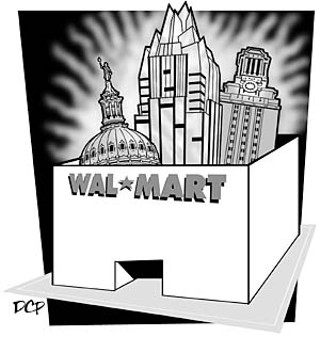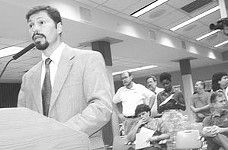Austin @ Large: Austin at Large
The Big-Box Toolbox: What Can Austin Do to Combat the Powercenter Plague? More Than You might Think.
By Mike Clark-Madison, Fri., Nov. 7, 2003

A joke, of sorts: What did the Irishman do in the big-box superstore? Nothing. There aren't any big-box stores in Ireland. There are, despite what you might think, plenty of such things in Europe -- both Wal-Marts and their local equivalents. But not in Ireland. It's the law. No retail establishment can be larger than 38,000 square feet, which is smaller than your typical HEB or Randalls. And they have to be located in, or within walking distance of, town centers. Auto-dependent highway-strip retail is illegal.
Yes, I know, Ireland is a different country, but it is an entire country that has done what some in Austin think is impossible, and done it for exactly the reasons many Austinites want to do it: to promote sustainable development and protect local businesses and urban commercial districts. On our side of the pond, the list of communities that have flat-out banned big boxes, defined purely by size, is neither long nor exhaustive -- mostly locally flavored rural locales that are, or want to be, in the tourist business, along with historic garden suburbs and carefully planned new towns. Were Austin actually to adopt a citywide retail size cap, we would be by far the largest U.S. jurisdiction to do so.
That's probably enough reason for it not to happen, given Austin's usual pride in being the last city to jump on any urban bandwagon. More realistic would be making superstores a "conditional use" -- requiring special blessing from City Hall on top of zoning and other entitlements that run with the land. Granting of a conditional-use permit could, or should, be contingent on an economic impact study, similar to the one Liveable City produced regarding the now-abandoned Borders proposed for Sixth and Lamar -- which showed quite clearly that a national chain sucks money out of the local economy. (Another recent study, conducted by Tischler and Associates for a town on sprawl-phobic Cape Cod, claims that big-box retail creates about 50 cents a square foot in annual net costs for localities, while local small-scale retail creates about 33 cents a square foot in net revenue.)
A Lose-Lose Proposition
This is part of a national debate about national chains, not just big boxes -- in many jurisdictions, it's fast-food restaurants that catch the greatest flak. By my lights, though, when a project in question is of a normal scale and in a normal urban setting, the free market can be trusted to take its course. (The problem with Sixth and Lamar, you may remember, was the city subsidy, not the Borders itself.) But stores the size of five football fields -- or of Austin's new City Hall and Seaholm Power Plant combined -- congregated in massive islands of negative urban space cannot exist without the active cooperation of local leaders. Said solons have typically been either too scared to admit or too lazy to figure out that, on top of the damage being done to their economies, they've gotten soaked for the externalized costs of such developments. (Look at La Frontera. Then look at the I-35/FM 1325 interchange. Then say "toll road" 10 times fast.)
But localities are also paying the opportunity costs of such profligate wastes of land. The parking lot of one Wal-Mart Supercenter could house several hundred people in single-family homes, yet -- even with 24-hour operation -- most of this land will instead be unused (but, of course, paved) most of the time. Remember that Austin has, in absolute terms, a serious housing shortage, and in relative terms a housing market whose disconnect from the actual housing needs -- and, yes, desires -- of the public would be envied by the Dadaists.
How's this for a design guideline: For every 10,000 feet of space within a big-box powercenter project, the developer has to build one on-site housing unit. (Before they get a certificate of occupancy for the retail.) Or, alternately, a requirement that big-box projects need to be modular and convertible -- into housing, or into smaller-scale retail -- with a minimum of effort once their chain tenants relocate to the next pasture. The challenges we've already faced redeveloping the last generation of commercial space -- from Northcross Mall, to Stassney and Manchaca, to the old Builders Square on Airport -- testify to the difficulties here. What the hell will happen to Sunset Valley and La Frontera when they lose their market charm?
Fight the Blight
None of this is really very radical -- even the president of the Real Estate Council of Austin publicly acknowledges (though, we must add, not when speaking for RECA) that big boxes are so ugly and dysfunctional that they need to be better regulated. If we applied as much energy to urban design controls for big boxes as we do to vertical buildings of the same size, we'd already be well ahead of the status quo. And despite its rep, the city of Austin is actually way behind the regional curve here -- our suburban neighbors in West Lake and Georgetown and Bee Cave and even Round Rock have all more assiduously demanded that big-box retail function as urban space.
You might not know this from reading the Statesman editorial board, which last week reflexively burbled out from its persistent vegetative state the familiar spin that the sins of big boxes are purely aesthetic, and thus venial rather than mortal. "Most buildings are big boxes. Some simply have more architectural relief." We could have a teachable Learning From Las Vegas moment here, where I throw around words like "megastructure" and impress our fans in the urban design business, but let's skip it. By most ordinary (or even "dumb and ordinary") measures of how cities actually work -- even auto-dependent cities like Austin -- big-box powercenters do not work very well. Yet we keep allowing them to be built.
Right now, the odd couple of Daryl Slusher and Brewster McCracken are handling the work of the angels here, at least when they're not sniping at each other on the dais. (You kids play nice!) According to McCracken, the consensus that we need to do something is strong enough from left, right, and center that we may see a big-box design draft before the council as early as January. And this week, Slusher asks the council to vote to initiate a study of the local economic impact of big-box development. Both are good first steps, but only first steps. Austin needs to prove itself willing and eager to actually use these tools -- and use them together -- instead of just leaving them in the (big) box. ![]()
Got something to say on the subject? Send a letter to the editor.









